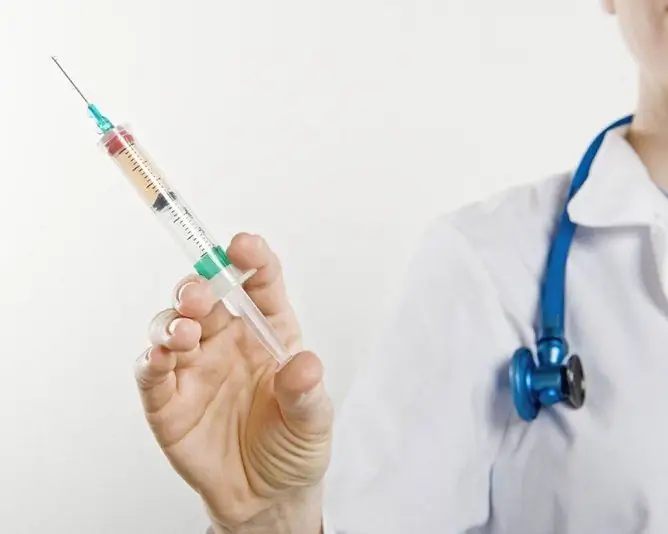- Author Rachel Wainwright [email protected].
- Public 2023-12-15 07:39.
- Last modified 2025-11-02 20:14.
Oxamp sodium
Oxamp sodium: instructions for use and reviews
- 1. Release form and composition
- 2. Pharmacological properties
- 3. Indications for use
- 4. Contraindications
- 5. Method of application and dosage
- 6. Side effects
- 7. Overdose
- 8. Special instructions
- 9. Application during pregnancy and lactation
- 10. Use in childhood
- 11. In case of impaired renal function
- 12. Drug interactions
- 13. Analogs
- 14. Terms and conditions of storage
- 15. Terms of dispensing from pharmacies
- 16. Reviews
- 17. Price in pharmacies
Latin name: Oxamp-sodium
ATX code: J01CR50
Active ingredient: ampicillin (Ampicillin) + oxacillin (Oxacillin)
Manufacturer: Sintez JSC (Russia)
Description and photo update: 2019-04-10

Oxamp sodium is a penicillinase-resistant combined broad-spectrum antibiotic.
Release form and composition
The drug is produced in the form of a powder for the preparation of a solution for intramuscular (i / m) administration / for intravenous (i / v) and (i / m) administration: white with a yellow tint, hygroscopic (for i / m) (133 each) 4 mg + 66.6 mg; 333.5 mg + 166.5 mg or 667 mg + 333 mg in a 10 or 20 ml vial; in a blister strip of 5 vials, in a cardboard box 1 or 2 packs or 1, 5 or 10 vials and instructions for the use of Oxamp-sodium; for hospitals - 50 vials in a cardboard box).
Composition for 1 bottle of powder for preparation of a solution for intramuscular injection or for intravenous and intramuscular administration: ampicillin sodium (ampicillin sodium salt sterile) in terms of ampicillin - 133.4; 333.5 or 667 mg; oxacillin sodium (sterile oxacillin sodium salt) in terms of oxacillin - 66.6; 166.5 or 333 mg, respectively.
Pharmacological properties
Pharmacodynamics
Oxamp sodium is a combined drug, the active ingredients of which are ampicillin and oxacillin.
Pharmacological action of Oxamp-sodium components:
- ampicillin: a substance from the group of semi-synthetic penicillins, has a bactericidal effect, acid-resistant. Shows activity in relation to gram-positive, not producing penicillinase (Streptococcus pneumoniae, Streptococcus spp., Staphylococcus spp.), And gram-negative (Neisseria meningitidis, Neisseria gonorrhoeae, Salmonella spp., Escherichia spp., Escherichia coli.;
- oxacillin: a semi-synthetic antibiotic of the penicillin series, resistant to the action of the enzyme penicillinase, acid-resistant. Demonstrates bactericidal action against gram-positive microorganisms (Streptococcus spp., Including Streptococcus pneumoniae; Staphylococcus spp., Bacillus anthracis, Corynebacterium diphtheriae, Actinomyces spp., Anaerobic Gram-negative spore-forming sticks, incl. Spp. cocci (Neisseria gonorrhoeae, Neisseria meningitidis) and some other gram-negative bacteria (Proteus mirabilis, Escherichia coli, Klebsiella pneumoniae, Haemophilus influenzae, Treponema spp., Actinomyces spp.). Non-fermenting gram-negative microorganisms, including Pseudomonas aeruginosa, most strains of Proteus vulgaris, Morganella morganii, are resistant to the effects of Oxamp sodium. Providencia rettgeri.
Pharmacokinetics
For both active ingredients after i / m administration, the time to reach the maximum concentration (T Cmax) in the blood is 0.5-1 h. The drug penetrates well into various organs and tissues.
After intravenous administration, after 5-10 minutes, levels of the drug content are recorded that exceed those with intramuscular injections.
Both active substances of the antibiotic are excreted by the kidneys and partly with bile. The half-life (T 1/2) is 1-2 hours. Cumulation of the drug with repeated injections is not observed.
Indications for use
Oxamp sodium is recommended for the treatment of the following infectious and inflammatory lesions of systems and organs caused by pathogens sensitive to the drug:
- respiratory system: bronchitis, pneumonia;
- ENT organs: tonsillitis, sinusitis, otitis media;
- genitourinary system: urethritis, pyelitis, cystitis, pyelonephritis, cervicitis, gonorrhea;
- digestive system: cholangitis, cholecystitis;
- skin and soft tissues: impetigo, erysipelas, secondarily infected dermatoses and other infections.
Also Oxamp sodium is indicated for use in the following diseases / conditions:
- infections in newborns (infection of the amniotic fluid; impaired breathing of the newborn, which requires resuscitation measures; the threat of aspiration pneumonia) - for prevention;
- postoperative complications during surgery, including against the background of immunodeficiency - for prevention purposes;
- severe infectious diseases (endocarditis, meningitis, sepsis, postpartum infection).
Contraindications
Absolute:
- Infectious mononucleosis;
- lymphocytic leukemia;
- hypersensitivity to the constituents of Oxamp sodium.
Relative - for a solution for intravenous and intramuscular administration (the drug should be used with extreme caution):
- renal failure;
- a history of bleeding;
- a history of allergic reactions and / or bronchial asthma;
- a history of indications of enterocolitis that arose during antibiotic therapy.
It is recommended to use Oxamp sodium with caution in children whose mothers are hypersensitive to penicillins.
Oxamp sodium, instructions for use: method and dosage
A solution prepared from Oxamp-sodium powder is injected i / m and i / v (jet or drip).
The doses of the drug indicated below are the sum of the dosages of the sodium salts of ampicillin and oxacillin in their fixed ratio of 2 ÷ 1. Thus, in the dosages recommended below, 1000 mg of the drug is equivalent to the amount of 667 mg of ampicillin + 333 mg of oxacillin, and 500 mg is equivalent to the amount of 333.5 mg ampicillin + 166.5 mg oxacillin.
The daily dose of Oxamp sodium depends on the patient's age and can be:
- newborns, premature babies and children under 1 year old - 100-200 mg / kg;
- children 1-6 years old - 100 mg / kg;
- children 7-14 years old - 50 mg / kg (solution for intravenous and intramuscular administration) or 100 mg / kg (solution for intravenous administration);
- adolescents over 14 years old and adults - 3000-6000 mg.
The frequency of injections of Oxamp sodium is 3-4 times a day with an interval of 6-8 hours. If necessary, the above doses can be increased by 1.5-2 times. The duration of therapy is determined depending on the severity of the infection and can range from 5-10 to 14-21 days, and in chronic processes - up to several months.
In order to prepare a solution for intramuscular injection, the contents of the bottle are 133.4 + 66.6 mg; 333.5 + 166.5 mg or 667 + 333 mg must be dissolved in water for injection at a dose of 2, 5 or 10 ml, respectively.
If necessary, jet injection of Oxamp-sodium into a vein, a single dose should be diluted in water for injection or a solution of sodium chloride 0.9%, taken in an amount of 10-15 ml. The duration of the introduction should be 2-3 minutes.
In case of need for intravenous drip infusion for adults, it is recommended to dilute a single dose of Oxamp-sodium in a solution of sodium chloride 0.9% or a solution of dextrose (glucose) 5% at a dose of 100-200 ml and inject at a rate of 60-80 drops / min. For children, a solution of dextrose (glucose) 5-10% at a dose of 30-100 ml is used as a solvent. IV injection is carried out for 5-7 days, then the patient is prescribed i / m injection.
Solutions must be injected immediately after preparation.
Side effects
- immune system: skin hyperemia, itching and flaking of the skin, conjunctivitis, urticaria, rhinitis, angioedema; rarely - arthralgia, fever, eosinophilia, anaphylactic shock; with intravenous administration - exfoliative dermatitis, erythematous and maculopapular rash, exudative erythema multiforme (including Stevens-Johnson syndrome), reactions similar to serum sickness; in isolated cases - non-allergic ampicillin rash (can pass without canceling the drug);
- gastrointestinal tract: change in taste, dysbiosis, diarrhea, vomiting, nausea, moderate increase in the activity of hepatic transaminases; rarely - pseudomembranous colitis;
- local reactions: at the injection site - pain, phlebitis and periphlebitis (with intravenous injection), infiltration (with intramuscular injection);
- laboratory parameters: anemia, leukopenia, neutropenia; with intravenous administration - proteinuria, hematuria;
- others: superinfection (mainly in people with chronic diseases or reduced body resistance); with intravenous administration - vaginal candidiasis, interstitial nephritis, nephropathy.
Overdose
Symptoms of an Oxamp-sodium overdose can be the following manifestations of its toxic effects on the central nervous system (CNS), primarily in patients with renal failure: tremor, headache, convulsions. In addition, side reactions of a violation of the water-electrolyte balance are possible: vomiting, nausea, diarrhea.
Treatment in this case is symptomatic. The drug is eliminated by hemodialysis.
special instructions
During the course of treatment, the state of the liver, kidney and hematopoietic organs should be monitored.
If signs of anaphylactic shock occur, it is necessary to immediately administer epinephrine (adrenaline), glucocorticosteroids (prednisolone or hydrocortisone) and antihistamines to the patient. If necessary, artificial lung ventilation is required.
If the patient has an increased sensitivity to penicillins, there is a risk of developing cross-allergic reactions with cephalosporin antibiotics.
If it is necessary to use Oxamp sodium for the treatment of patients with such concomitant diseases as hay fever, bronchial asthma, and other allergic diseases, it is recommended to simultaneously prescribe desensitizing drugs.
The possibility of superinfection as a result of the growth of microflora resistant to Oxamp-sodium requires appropriate correction of antibacterial therapy.
Application during pregnancy and lactation
The use of Oxamp sodium during pregnancy is possible only if the expected benefit from the treatment to the mother outweighs the possible threat to the fetus.
It has been established that Oxamp sodium is excreted in breast milk, therefore, if it is necessary to use it during lactation, it is necessary to transfer the child to artificial feeding.
Pediatric use
For children, Oxamp sodium can be prescribed from the day of birth according to indications according to the dosage regimen.
Caution should be exercised in pediatric patients whose mothers have a history of hypersensitivity to penicillins.
With impaired renal function
A solution for intravenous and intramuscular administration in the presence of renal failure is recommended to be used with caution. In patients with renal insufficiency, if Oxamp sodium is used in high doses, a toxic effect on the central nervous system may be recorded.
Drug interactions
Possible interaction of Oxamp-sodium with simultaneously used medicinal substances / preparations, due to the presence of ampicillin in its composition:
- cephalosporins, aminoglycosides, rifampicin, vancomycin, cycloserine and other bactericidal antibiotics: a synergistic effect is recorded;
- lincosamides, macrolides, chloramphenicol, sulfonamides, tetracyclines and other bacteriostatic drugs: antagonistic effect is noted;
- indirect anticoagulants: the effectiveness of these agents increases as a result of suppression of the intestinal microflora, a decrease in the prothrombin index and a decrease in the production of vitamin K;
- aminoglycosides: are pharmaceutically incompatible with ampicillin;
- drugs, during the metabolism of which para-aminobenzoic acid is formed; estrogen-containing oral contraceptives: the effectiveness of these drugs decreases;
- allopurinol: the risk of skin rash increases;
- ethinyl estradiol: its effect is weakened and the threat of breakthrough bleeding is aggravated;
- methotrexate: clearance decreases and the toxicity of this substance increases;
- nonsteroidal anti-inflammatory drugs, oxyphenbutazone, diuretics, phenylbutazone, allopurinol and other drugs that interfere with tubular secretion: the concentration of ampicillin in plasma increases as a result of a decrease in tubular secretion.
Possible interaction of Oxamp sodium with simultaneously used medicinal substances / preparations, due to the presence of oxacillin in its composition:
- bacteriostatic antibiotics: decrease in effectiveness is recorded; not recommended combination;
- drugs that inhibit tubular secretion: the content of oxacillin in the blood increases;
- medicinal products with hepatotoxic effect: it is necessary to avoid combined use with oxacillin;
- methotrexate: as a result of competition for tubular secretion, the toxicity of this substance increases;
- calcium folinate (antidote to folate antagonists): higher doses of this drug and longer use may be necessary.
Analogs
Analogs of Oxamp sodium are Ademetionine, Ampiox sodium, Oxamp, Ampiox, Oxamsar, etc.
Terms and conditions of storage
Store in a place protected from moisture and light, out of reach of children, at a temperature not exceeding 20 ° C.
Shelf life is 2 years.
Terms of dispensing from pharmacies
Dispensed by prescription.
Reviews of Sodium Oxamp
On specialized sites, reviews of Sodium Oxamp are extremely rare, for the most part they are positive. Patients note the effectiveness of the drug in the treatment of diseases caused by microorganisms sensitive to this antibiotic. It quickly reduces fever and helps to eliminate the symptoms of infection. Also, the advantages of the tool include its low cost.
There are no complaints about the development of adverse events against the background of the administration of injections of Oxamp sodium.
Price for Oxamp sodium in pharmacies
The price of Oxamp sodium, a powder for preparing a solution for intramuscular administration (333.5 + 166.5 mg), can be 18 rubles. for 1 bottle of 20 ml.

Anna Kozlova Medical journalist About the author
Education: Rostov State Medical University, specialty "General Medicine".
Information about the drug is generalized, provided for informational purposes only and does not replace the official instructions. Self-medication is hazardous to health!






